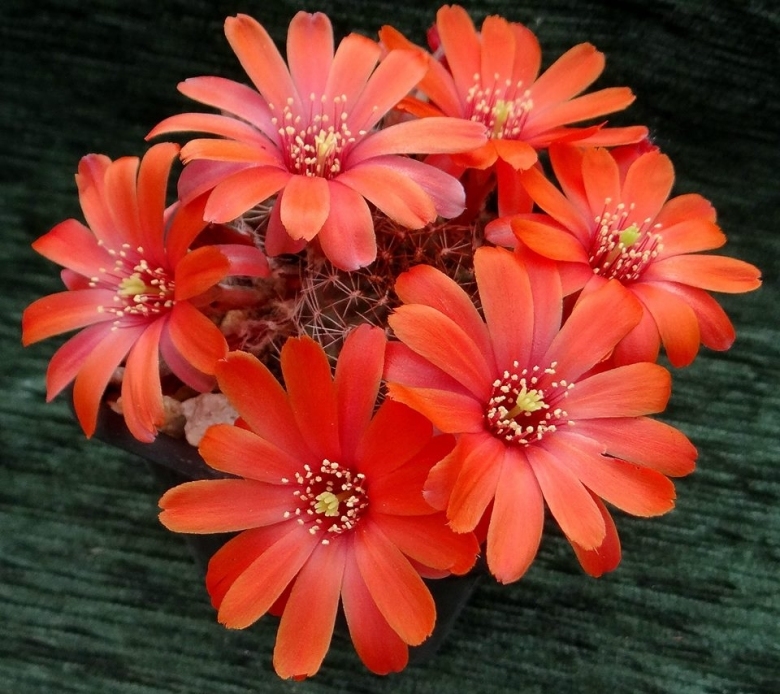= Rebutia spegazziniana var. boliviensis n.n., Rausch
Accepted Scientific Name: Rebutia spegazziniana Backeb.
Kakteen-Freunde ii. No. 1, (1933); Backeb. Blatter Kakteenforsch. 1934, Pr. 2,[p. 8].

Rebutia boliviensis (Rebutia spegazziniana var. boliviensis) Photo by: Agócs György
Origin and Habitat: Rio Bermejo, Tarija, Bolivia (field numbers: WR 922 and VJ 76)
Synonyms:
See all synonyms of Rebutia spegazziniana
back
Accepted name in llifle Database:Rebutia spegazziniana Backeb.Kakteen-Freunde ii. No. 1, (1933); Backeb. Blatter Kakteenforsch. 1934, Pr. 2,[p. 8].Synonymy: 35
back
Description: Rebutia spegazziniana var. boliviensisSN|5033]]SN|31286]] is an undescribed name (n.n.) firstly published in Köhres seed catalog in 1974, and used to indicate one of the innumerable local form of the variable Rebutia spegazzinianaSN|4953]]SN|5033]] with bright carmine-red flowers, but others forms are similar and plants from other localities look more like it. Rebutia spegazziniana var. boliviensisSN|31286]]SN|31286]] is variable and has also at times been referred to a form of Rebutia deminutaSN|5033]]SN|4953]]. Anyway (whatever the scientific name is) this easy to grow cactus is highly priced for its vibrant red blooms.
Remarks: Rebutia spegazzinianaSN|31286]]SN|5033]] is a widespread and variable species that has received an undue number of names. The differences usually concern only the spination, however the colouring, size and density of spines is greatly influenced by the conditions of culture, at lower light levels the spines are less numerous, delicate and white, while with strong solar radiation the spines are stronger with a darker tint. Minor differences can also be found in the colour of flowers sometime with a more pink or orange tint.
Subspecies, varieties, forms and cultivars of plants belonging to the Rebutia spegazziniana group
- Rebutia froehlichiana Rausch
 Rebutia fusca F.Ritter: has tiny bristle spines and vibrant orange-red flower. Distribution: Oruro, Tarija, Bolivia.
Rebutia fusca F.Ritter: has tiny bristle spines and vibrant orange-red flower. Distribution: Oruro, Tarija, Bolivia.- Rebutia mamillosa Rausch: has dark greenish brown bodies becoming bronzed purple in full sun and forms small clumps of small heads around 20 mm across. Flowers dark red, ca. 2,5 cm in diameter with showy white stamens. Distribution: west of Camargo and adjacent areas, Chuquisaca, Bolivia.
 Rebutia mamillosa var. australis F.Ritter: has bodies 20-30 mm wide, 10-15 ribs, 12-20 radial spines, 3-6 mm long and 0-4 centrals equal in length. Flowers 26-46 mm long with white filaments. Distribution: Habitat, San Antonio, Prov. Mendez, Bolivia.
Rebutia mamillosa var. australis F.Ritter: has bodies 20-30 mm wide, 10-15 ribs, 12-20 radial spines, 3-6 mm long and 0-4 centrals equal in length. Flowers 26-46 mm long with white filaments. Distribution: Habitat, San Antonio, Prov. Mendez, Bolivia.- Rebutia mamillosa var. orientalis F.Ritter: has areoles abundantly filled with white wool, 0-4 radial spines, 5-7 mm long, darker at base. Distribution: Tarija towards the south, Bolivia.
 Rebutia patericalyx F.Ritter: has vibrant orange-red flower and tiny bristle spines covered by tiny hairs. Distribution: La Queva, Chuquisaca, Bolivia.
Rebutia patericalyx F.Ritter: has vibrant orange-red flower and tiny bristle spines covered by tiny hairs. Distribution: La Queva, Chuquisaca, Bolivia.- Rebutia rubiginosa F.Ritter
 Rebutia spegazziniana Backeb.: widespread and variable species that will clump with age and produces large and beautiful bright red flowers. Distribution: Bolivia and Argentina.
Rebutia spegazziniana Backeb.: widespread and variable species that will clump with age and produces large and beautiful bright red flowers. Distribution: Bolivia and Argentina. Rebutia spegazziniana var. atroviridis (Backeb.) Šída: has darker bluish grey-green skin and lighter, weaker spines. Blooms dark red. Distribution: Bolivia and Argentina.
Rebutia spegazziniana var. atroviridis (Backeb.) Šída: has darker bluish grey-green skin and lighter, weaker spines. Blooms dark red. Distribution: Bolivia and Argentina. Rebutia spegazziniana var. boliviensis n.n., Rausch
Rebutia spegazziniana var. boliviensis n.n., Rausch- Rebutia sumayana Rausch
- Rebutia tarijensis Rausch
 Rebutia tarvitaensis F.Ritter: has grey-green to olive-green epidermis with violet tints and orange-red blooms. Distribution: Tarvita, Chuquisaca, Bolivia.
Rebutia tarvitaensis F.Ritter: has grey-green to olive-green epidermis with violet tints and orange-red blooms. Distribution: Tarvita, Chuquisaca, Bolivia.- Rebutia tuberosa F.Ritter
 Rebutia vulpina F.Ritter: Flowers are bright red, the petals tipped scarlet, stigma and stamens white. Distribution: Bolivia, Tarija, Mendez, west of Tarija.
Rebutia vulpina F.Ritter: Flowers are bright red, the petals tipped scarlet, stigma and stamens white. Distribution: Bolivia, Tarija, Mendez, west of Tarija.- Rebutia zecheri Rausch
Cultivation and Propagation: Rebutia spegazziniana var. boliviensisSN|31286]]SN|31286]] is easy to grow and recommended for beginners. Prefer gritty, porous mix with a pH slightly on the acidic side. Full sun to light shade, Water regularly in summer but do not overwater (the root system is rot prone) and allow the pot to dry out between waterings. Keep dry in winter Hardy to -4°C it will take low temperatures when dry and do require a winter rest period. This species will occupy a small flower pot comfortably and remain a manageable sized house plant.
Pest and disease: This plants are subject to mealy-bug attack and to fungus and rot problems brought about by overwatering and high humidity.
Propagation: Seed or offsets.










